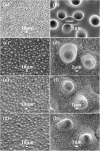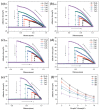Computational Intelligence-Assisted Understanding of Nature-Inspired Superhydrophobic Behavior
- PMID: 29375975
- PMCID: PMC5770681
- DOI: 10.1002/advs.201700520
Computational Intelligence-Assisted Understanding of Nature-Inspired Superhydrophobic Behavior
Abstract
In recent years, state-of-the-art computational modeling of physical and chemical systems has shown itself to be an invaluable resource in the prediction of the properties and behavior of functional materials. However, construction of a useful computational model for novel systems in both academic and industrial contexts often requires a great depth of physicochemical theory and/or a wealth of empirical data, and a shortage in the availability of either frustrates the modeling process. In this work, computational intelligence is instead used, including artificial neural networks and evolutionary computation, to enhance our understanding of nature-inspired superhydrophobic behavior. The relationships between experimental parameters (water droplet volume, weight percentage of nanoparticles used in the synthesis of the polymer composite, and distance separating the superhydrophobic surface and the pendant water droplet in adhesive force measurements) and multiple objectives (water droplet contact angle, sliding angle, and adhesive force) are built and weighted. The obtained optimal parameters are consistent with the experimental observations. This new approach to materials modeling has great potential to be applied more generally to aid design, fabrication, and optimization for myriad functional materials.
Keywords: artificial neural networks; computational intelligence; evolutionary computation; superhydrophobic behavior.
Figures






Similar articles
-
Facile spray-coating process for the fabrication of tunable adhesive superhydrophobic surfaces with heterogeneous chemical compositions used for selective transportation of microdroplets with different volumes.ACS Appl Mater Interfaces. 2014 Jun 11;6(11):8868-77. doi: 10.1021/am5015937. Epub 2014 May 20. ACS Appl Mater Interfaces. 2014. PMID: 24807195
-
Bioinspired super-antiwetting interfaces with special liquid-solid adhesion.Acc Chem Res. 2010 Mar 16;43(3):368-77. doi: 10.1021/ar900205g. Acc Chem Res. 2010. PMID: 19954162 Review.
-
Fabrication of superhydrophobic bionic surface integrating with VOF simulation studies of liquid drop impacting.Microsc Res Tech. 2019 May;82(5):615-623. doi: 10.1002/jemt.23208. Epub 2019 Jan 21. Microsc Res Tech. 2019. PMID: 30666735
-
Asymmetric Superhydrophobic/Superhydrophilic Cotton Fabrics Designed by Spraying Polymer and Nanoparticles.ACS Appl Mater Interfaces. 2016 Jan 13;8(1):651-9. doi: 10.1021/acsami.5b09782. Epub 2015 Dec 24. ACS Appl Mater Interfaces. 2016. PMID: 26595458
-
Mimicking natural superhydrophobic surfaces and grasping the wetting process: a review on recent progress in preparing superhydrophobic surfaces.Adv Colloid Interface Sci. 2011 Dec 12;169(2):80-105. doi: 10.1016/j.cis.2011.08.005. Epub 2011 Sep 14. Adv Colloid Interface Sci. 2011. PMID: 21974918 Review.
Cited by
-
Bioinspired Designs of Superhydrophobic and Superhydrophilic Materials.ACS Cent Sci. 2018 Sep 26;4(9):1102-1112. doi: 10.1021/acscentsci.8b00504. Epub 2018 Aug 29. ACS Cent Sci. 2018. PMID: 30276243 Free PMC article. Review.
-
Recent Advances in Superhydrophobic Materials Development for Maritime Applications.Adv Sci (Weinh). 2024 Apr;11(16):e2308152. doi: 10.1002/advs.202308152. Epub 2024 Feb 25. Adv Sci (Weinh). 2024. PMID: 38403472 Free PMC article. Review.
References
-
- a) Rezayi T., Entezari M. H., Surf. Coat. Technol. 2017, 309, 795;
- b) Cho E.‐C., Chang‐Jian C.‐W., Chen H.‐C., Chuang K.‐S., Zheng J.‐H., Hsiao Y.‐S., Lee K.‐C., Huang J.‐H., Chem. Eng. J. 2017, 314, 347.
-
- a) Liu Y., Li X., Jin J., Liu J., Yan Y., Han Z., Ren L., Appl. Surf. Sci. 2017, 400, 498;
- b) Wang Y., Xue J., Wang Q., Chen Q., Ding J., ACS Appl. Mater. Interfaces 2013, 5, 3370. - PubMed
-
- a) Xue Z., Wang S., Lin L., Chen L., Liu M., Feng L., Jiang L., Adv. Mater. 2011, 23, 4270; - PubMed
- b) Lu Y., Sathasivam S., Song J., Chen F., Xu W., Carmalt C. J., Parkin I. P., J. Mater. Chem. A 2014, 2, 11628.
-
- a) Lu Y., Sathasivam S., Song J., Crick C. R., Carmalt C. J., Parkin I. P., Science 2015, 347, 1132; - PubMed
- b) Sutha S., Suresh S., Raj B., Ravi K. R., Sol. Energy Mater. Sol. Cells 2017, 165, 128;
- c) Wang P., Chen M., Han H., Fan X., Liu Q., Wang J., J. Mater. Chem. A 2016, 4, 7869.
-
- a) Barthlott W., Neinhuis C., Planta 1997, 202, 1;
- b) Parkin I. P., Palgrave R. G., J. Mater. Chem. 2005, 15, 1689.
LinkOut - more resources
Full Text Sources
Other Literature Sources
